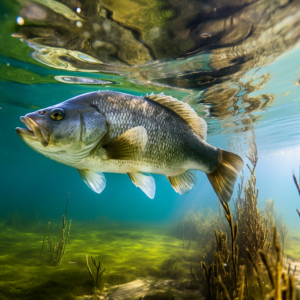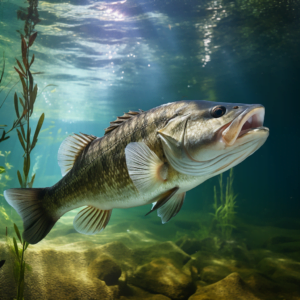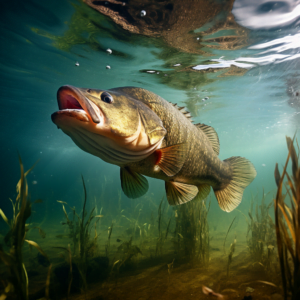So, you’re wondering if largemouth bass is good to eat, huh? Well, let me tell you, there are definitely some pros and cons to consider. Largemouth bass is a popular game fish, widely sought after by anglers for its size and fight. But when it comes to putting it on your dinner plate, there are a few things you should know.
On the plus side, largemouth bass can be quite tasty. It has a mild flavor, similar to other white fish like cod or haddock. When cooked properly, it’s flaky and tender, making it a great choice for fish tacos, fish and chips, or simply grilled with some lemon and herbs. It’s also a low-fat, high-protein option, which can be a healthy addition to your diet.
However, there are also some drawbacks to consider. Largemouth bass, like many other predatory fish, can accumulate high levels of mercury, which can be harmful if consumed in large quantities. Therefore, it’s important to be mindful of where the fish is caught and to limit your consumption, especially if you’re pregnant or nursing. Additionally, largemouth bass populations are not unlimited, and overfishing can have detrimental effects on the ecosystem. So, if you do choose to eat largemouth bass, it’s important to do so responsibly and within sustainable limits.
So now you have a better idea of the pros and cons of eating largemouth bass. If you want to learn more about how to prepare and cook this fish, and about sustainable fishing practices, be sure to check out the full article.
The Pros and Cons of Eating Largemouth Bass
Largemouth bass, scientifically known as Micropterus salmoides, is a popular freshwater fish among anglers. Known for its distinct appearance and powerful fighting abilities, this fish contributes to a thrilling fishing experience. However, it begs the question: is largemouth bass good to eat? In this article, we will explore the health benefits of consuming largemouth bass, as well as the potential drawbacks and alternative fish options.
| Aspect | Largemouth Bass | Salmon | Rainbow Trout | Sardines |
|---|---|---|---|---|
| Nutritional Benefits | ||||
| Protein (per 100g) | Approx. 20g | Approx. 25g | Approx. 20g | Approx. 25g |
| Omega-3 (per 100g) | Moderate | High | Moderate | High |
| Vitamins | B12, D | B12, D, A | B12, D | B12, D |
| Conservation Status | Varies by Region | Varies by Region | Varies by Region | Generally Stable |
| Overfishing Concerns | Some | Yes | Some | Lower |
| Cooking Methods | ||||
| Best Cooking Method | Grilling, Pan-Frying | Grilling, Baking | Grilling, Baking | Grilling, Pan-Frying |
| Suitable for Fish Tacos? | Yes | Yes | Yes | Yes |
| Sustainability | ||||
| Sustainable Alternatives | Rainbow Trout | Sardines | Largemouth Bass | Salmon, Trout |
| Efforts Needed | Follow Local Regulations | Select Wild-Caught | Follow Local Regulations | Choose Smaller Varieties |
| Potential Risks | ||||
| Mercury Levels | Medium to High | Medium | Low to Medium | Low |
| Parasitic Infection Risk | Yes | Low | Yes | Low |
Health Benefits of Eating Largemouth Bass
High Protein Content
One of the key health benefits of eating largemouth bass is its high protein content. Protein is an essential macronutrient that plays a crucial role in building and repairing tissues, promoting muscle growth, and supporting a healthy immune system. A 3-ounce serving of largemouth bass provides approximately 21 grams of protein, making it an excellent choice for those looking to increase their protein intake.
Rich in Omega-3 Fatty Acids
Largemouth bass also offers a good source of omega-3 fatty acids, which are well-known for their numerous health benefits. Omega-3s have been linked to reducing inflammation, improving heart health, and supporting brain function. Incorporating largemouth bass into your diet can help increase your omega-3 intake and promote optimal overall health.
Good Source of Vitamins and Minerals
In addition to protein and omega-3s, largemouth bass is rich in essential vitamins and minerals. It contains significant amounts of vitamins B12 and D, as well as minerals like selenium and phosphorus. These nutrients play a vital role in various bodily functions, including energy production, immune function, and bone health, among others. Consuming largemouth bass can be a great way to boost your nutrient intake and ensure overall well-being.
Cons of Eating Largemouth Bass
While largemouth bass offers several health benefits, there are also some potential drawbacks to consider before adding it to your regular diet.
Mercury Contamination
One of the primary concerns with consuming largemouth bass is the risk of mercury contamination. Mercury is a toxic heavy metal that can accumulate in fish, especially in larger predator species like bass. Over time, mercury can build up in the human body and lead to various health issues, particularly affecting the nervous system. It is advisable to limit consumption of largemouth bass, especially for pregnant women, nursing mothers, and young children due to their increased vulnerability to mercury’s harmful effects.
Risk of Parasitic Infections
Another consideration when consuming largemouth bass is the potential risk of parasitic infections. Like many freshwater fish, largemouth bass can carry parasites such as tapeworms, roundworms, and flukes. These parasites can cause gastrointestinal issues and other health problems if not properly cooked or if the fish is consumed raw. It is crucial to ensure thorough cooking of largemouth bass to eliminate any potential parasites and reduce the risk of infection.
Environmental Considerations
Lastly, eating largemouth bass may raise environmental concerns. While catch-and-release practices are widely promoted to preserve fish populations, the consumption of largemouth bass contributes to the demand for these fish. Overfishing can result in the depletion of the species and disrupt the balance of aquatic ecosystems. Additionally, some regions may experience water pollution, affecting the quality and safety of largemouth bass. It is essential to consider the environmental impact before deciding to include largemouth bass in your diet.
Cooking and Preparation Tips for Largemouth Bass
If you choose to eat largemouth bass, it is important to know how to cook and prepare it properly to maximize flavor and minimize potential risks.
Grilling
Grilling largemouth bass can be a wonderful way to bring out its natural flavors while maintaining its moist and tender texture. Before grilling, make sure to properly clean and dry the fish. Season with your favorite herbs and spices, such as lemon pepper, garlic, or dill. Preheat the grill to medium-high heat and brush it with oil to prevent sticking. Cook the fish for about 4-6 minutes per side, or until the internal temperature reaches 145°F (63°C). Serve with a squeeze of fresh lemon juice for a delicious and healthy meal.
Baking
Baking largemouth bass is a simple and convenient cooking method that retains moisture and flavor. Preheat the oven to 400°F (200°C) and lightly oil a baking dish. Season the fish with herbs, spices, and a drizzle of olive oil. Place the fish in the baking dish and bake for approximately 12-15 minutes, or until it flakes easily with a fork. Garnish with fresh herbs, such as parsley or cilantro, and serve alongside your favorite vegetables or a side salad.
Pan-Frying
Pan-frying largemouth bass creates a crispy and golden brown exterior while keeping the flesh tender and moist. Start by seasoning the fish with salt and pepper or your preferred seasonings. In a skillet, heat a small amount of oil over medium-high heat. Place the fish fillets into the pan, skin side down if applicable, and cook for about 3-4 minutes per side, or until the fish is cooked through and the skin is crispy. Squeeze a wedge of lemon over the fish before serving to add a bright, citrusy flavor.
Alternative Fish Options for Healthier Eating
If you are seeking healthier alternatives to largemouth bass, here are a few options that provide similar health benefits:
Salmon
Salmon is renowned for its high content of omega-3 fatty acids, making it an excellent choice for heart health and brain function. It also offers a rich flavor and a tender texture, making it a popular choice among seafood lovers.
Rainbow Trout
Rainbow trout is another nutritious option that is low in calories and high in protein. It is also a good source of omega-3 fatty acids, vitamins, and minerals. With its delicate and mild flavor, rainbow trout is versatile and can be prepared in a variety of ways.
Sardines
Sardines are small, oily fish that are packed with omega-3 fatty acids, calcium, and vitamin D. They are often considered a sustainable choice since they are abundant and reproduce rapidly. Sardines have a distinct, savory flavor that pairs well with various dishes, from salads to pasta.
Sustainable Fishing Practices for Largemouth Bass
If you enjoy fishing for largemouth bass, it is important to practice sustainable fishing techniques to protect the species and their habitats.
Catch and Release
Catch and release is a widely encouraged practice that allows anglers to enjoy the thrill of catching largemouth bass while ensuring their survival. By carefully handling the fish and releasing them back into the water, anglers can help preserve the population and maintain the ecological balance.
Fishing Regulations
It is essential to familiarize yourself with the fishing regulations in your specific area. These regulations vary depending on the location and may include limitations on the number and size of largemouth bass that can be harvested. Respecting these regulations helps protect the sustainability of the fishery and ensures the longevity of the largemouth bass population.
Supporting Local Fisheries
Supporting local fisheries and purchasing from reputable sources can also contribute to sustainable fishing practices. Choose suppliers who practice ethical and responsible fishing methods, as they prioritize environmental conservation and maintain healthy fish stocks.
Culinary Uses of Largemouth Bass
Largemouth bass’s versatility in the kitchen allows for a wide range of culinary uses. Here are a few popular ways to incorporate largemouth bass into your meals.
Fish Tacos
Largemouth bass can be an excellent choice for fish tacos, bringing a fresh and delicious taste to this popular dish. Season and grill the fish until flaky, then serve it in soft tortillas with your favorite toppings, such as shredded cabbage, salsa, avocado, and a squeeze of lime. The combination of flavors creates a satisfying and healthy meal.
Fish Cakes
Transforming largemouth bass into fish cakes is another great option. Flake the cooked fish and combine it with breadcrumbs, herbs, spices, and an egg to bind the mixture. Shape the mixture into patties and pan-fry until golden brown. Serve the fish cakes with a side of mixed greens or a tangy sauce for a delightful and nutritious meal.
Fish Stew
Largemouth bass can also lend itself well to hearty and comforting fish stews. Simmer the fish with aromatic vegetables, such as onions, garlic, and tomatoes, along with herbs and spices of your choice. Add broth or coconut milk, and let the flavors meld together over low heat. Serve the fish stew with crusty bread for a satisfying and nourishing meal.
Tips for Identifying Fresh Largemouth Bass
To ensure that the largemouth bass you consume is fresh and of the highest quality, keep the following tips in mind:
Clear Eyes
Fresh largemouth bass should have clear, bright eyes without any cloudiness or milky appearance. Cloudy or discolored eyes could indicate that the fish is not fresh or has been improperly stored.
Firm Flesh
Gently press the flesh of the largemouth bass with your finger. It should feel firm and bounce back when touched. If the flesh feels soft or leaves an imprint, it may be a sign of spoilage.
Mild, Fresh Odor
Fresh largemouth bass should have a mild, oceanic smell. If the fish smells overly fishy, ammonia-like, or unpleasant, it is best to avoid it, as it may be an indication of decomposition.
Precautions When Consuming Largemouth Bass
While largemouth bass can be a healthy addition to your diet, it is important to be mindful of certain precautions to ensure food safety and minimize potential health risks.
Limiting Consumption for Pregnant Women and Children
Due to the potential for mercury contamination, pregnant women, nursing mothers, and young children should limit their consumption of largemouth bass. These individuals are more susceptible to the adverse effects of mercury, which can harm a developing fetus or young child’s neurological development.
Avoiding Fish from Polluted Waters
Largemouth bass inhabits freshwater bodies, some of which may be contaminated by pollution from industrial run-off, agricultural practices, or other human activities. To minimize exposure to pollutants, it is advisable to avoid consuming largemouth bass from waters with known pollution issues or to consult local health advisories.
Proper Cooking Temperatures
To eliminate any potential parasites and ensure food safety, largemouth bass must be cooked thoroughly. The internal temperature of the fish should reach 145°F (63°C) to kill any harmful bacteria or parasites. Use a food thermometer to accurately measure the temperature and ensure proper cooking.
Potential Impact on Largemouth Bass Population
While largemouth bass can be a tasty and nutritious option, it is crucial to consider the potential impact on the fish population and the environment.
Overfishing Concerns
Overfishing poses a significant threat to largemouth bass populations. Excessive harvesting can deplete fish stocks, disrupt the ecosystem, and threaten the survival of the species. It is important to practice responsible fishing techniques, follow local fishing regulations, and support sustainable fishing practices to safeguard largemouth bass populations for future generations.
Environmental Factors
The environmental conditions in which largemouth bass live can affect their quality and safety as a food source. Factors such as pollution, water quality, and habitat degradation can have a direct impact on the health of the fish. By being aware of these environmental factors and choosing fish from clean and well-managed waters, you can reduce the risk of contaminants and promote environmentally friendly practices.
Conservation Efforts
Efforts are being made to preserve largemouth bass populations and their habitats. Conservation organizations undertake research, implement fishery management plans, and educate the public about sustainable fishing practices. Supporting these conservation efforts can contribute to the long-term viability of largemouth bass and the ecosystems they inhabit.
Conclusion
In conclusion, largemouth bass offers several health benefits, including its high protein content, omega-3 fatty acids, and essential vitamins and minerals. However, it is crucial to weigh these pros against the potential cons, such as mercury contamination and the risk of parasitic infections. Additionally, considering the environmental impact of largemouth bass consumption is essential in making informed choices. By cooking largemouth bass properly, exploring alternative fish options, and supporting sustainable fishing practices, you can enjoy the benefits of eating fish while minimizing potential risks. Remember to prioritize food safety, limit consumption for vulnerable populations, and stay informed about fishing regulations and environmental concerns. With a balanced approach, you can savor the flavors of largemouth bass while ensuring the sustainability of fish populations and protecting the environment.




